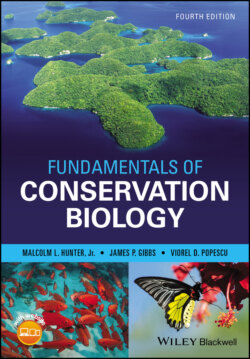Читать книгу Fundamentals of Conservation Biology - Malcolm L. Hunter Jr. - Страница 103
Utilitarian Values
ОглавлениеThe surreal images of a St. Bernard sitting on someone’s lap or a Chihuahua wading through alpine snows highlight the importance of the genetic diversity of domestic species. Or consider ankole watusi cattle raised as beef on a dry pasture in Malawi versus Holstein Friesian cattle on a lush pasture of a dairy farm in Belgium – they effectively cannot trade places or purposes (Fig. 5.11). This diversity reflects people having acted as agents of artificial selection to develop different forms of the same species for a variety of purposes: lap dogs and rescue dogs, corn for silage and corn for the dinner table, cherries to eat and cherry trees to admire, cows to milk or cows to eat, and so on (Virchow 1999 ; Mormède 2005). Just as important, it allows us to grow the same species in a variety of environments, each with a different climate and local suite of pathogens, predators, competitors, and so forth. Genetic diversity can also be exploited simply to satisfy our appetite for variety. The explosion of color and form in flower gardens and love of different types of hot peppers in cooking are strong testament to the saying, “variety is the spice of life.”
Figure 5.11 Ankole watusi cattle raised as beef on a dry pasture in Malawi versus Holstein Friesian cattle on lush pasture of a dairy farm in Belgium cannot effectively cannot trade places or purpose.
(Matthew Bellemare/Flickr/CC BY 2.0 [top] and Tobias Nordhausen/Flickr/CC BY 2.0 [bottom])
The genetic diversity of some wild populations is also important to plant and animal breeders because wild relatives of domestic species are a significant source of genetic material. For example, when scientists at the International Rice Research Institute in the Philippines set out to develop a variety of rice that would be resistant to a major disease, grassy stunt virus, they screened over 6000 varieties of rice and found only one variety that was resistant to the disease. That variety, a wild species of rice called Oryza nivara, was represented in their collection by only 30 kernels, of which only three showed resistance (Hoyt 1988). Returning to the area in north‐central India where the rice sample had been collected, they could find no new material; the original collection site had been inundated by a dam. Fortunately, this story still had a happy ending because they were able to use the genetic information in these three kernels to develop a new variety of rice, IR36, that is resistant to this virus and is planted across millions of hectares in Asia (Ma et al. 2016).
Differences within a species can be of strategic value to conservation because they provide a clear justification for protecting a species across its entire geographic range, including all subspecies and major populations. For example, the Plymouth red‐bellied turtle is protected in the US state of Massachusetts. The one population that occurs in Massachusetts is slightly differentiated from other red‐bellied turtles (cooters) (Browne et al. 1996) so protecting it helps protect the entire suite of genetic variation found in the species. Protecting it also increases the entire species range by 30–40%, and doing so benefits a wide variety of other biota that also depend on the turtles’ wetland habitat. We will return to this issue in Chapter 13, “Managing Populations.”
